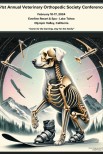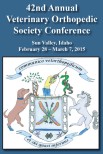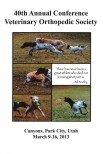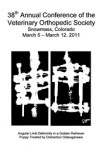Aims: To report short- and long-term outcomes of dogs with medial coronoid process disease (MCPD) treated by needle arthroscopy-assisted fragment removal (NA-FR) and to identify potential tomodensitometric and arthroscopic criteria associated with functional prognosis.
Methods: Medical records of dogs diagnosed with MCPD by CT and presented to a single veterinary teaching hospital, between 2021 and 2023 and treated with NA-FR were retrospectively reviewed. Data collected and analysed included: subjective lameness scores (0-5 scale) evaluated by surgeons before, and 15 days and 1 month after surgery; modified International Elbow Working Group (mIEWG; 0-12 scale) score determined by CT, modified Outerbridge score (MOS, 0-5 scale) assessed during surgery; and Canine Orthopaedic Index (COI; 16-80 scale) scores collected from owners at the time of presentation, 1 month after surgery and at long-term follow-up (≥ 12 months).
Results: Data from 41 clinically affected elbows (30 dogs) diagnosed with MCPD by CT were included. A decrease in lameness scores compared to before surgery was observed at 15 days (2 (IQR 2-3) vs. 0 (IQR 0-1); p = 0.05) and 30 days post-operatively (2 (IQR 2-3) vs. 0 (IQR 0-2); p = 0.0002). Dogs that were still lame 30 days post-operatively had a higher ulnar MOS than those that were no longer lame (3 (IQR 3-4) vs. 2 (IQR 2-3); p = 0.02). At long-term follow-up (median 24 (IQR 16-32) months after surgery; available for 18/30 dogs), there was a reduction in COI scores (median 21 (IQR 19-24)) compared to the pre-operative period (median 48 (IQR 45-56); p = 0.002). Furthermore, COI scores were higher in dogs having an ulnar or humeral MOS > 2 or mIEWG > 6 compared to those having an ulnar or humeral MOS ≤ 2 or mIEWG ≤ 6 (28 (IQR 25-44) vs. 19 (IQR 18-21), p = 0.004 and 26 (IQR 25-28) vs. 19 (IQR 19-23), p = 0.02).
Conclusions and clinical relevance: MCPD treated by NA-FR showed satisfactory short- and long-term post-operative outcomes. Increased humeral or ulnar MOS scores as well as modified IEWG scores were associated in our study with a poorer long-term outcome. Further assessments are needed to validate this strategy and to establish the criteria for identifying dogs that will best benefit from NA-FR.









